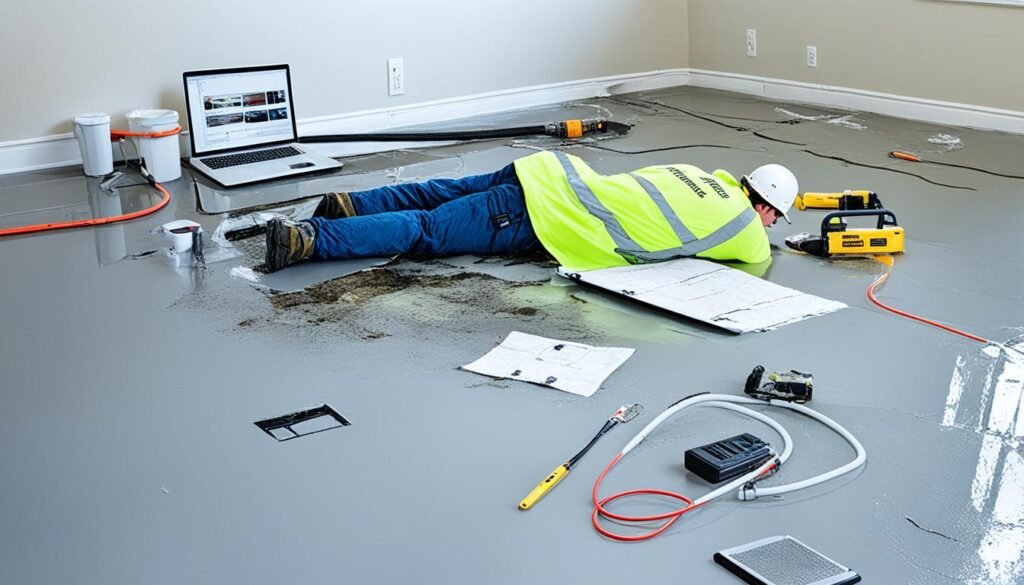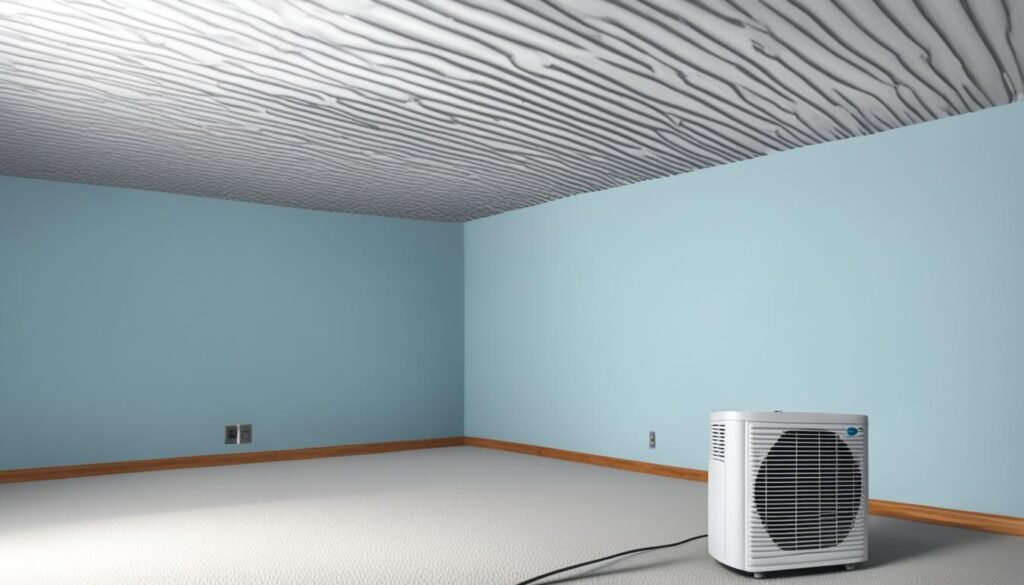Did you know things dried in 48 hours stand a better chance of being saved from damage? This fact shows how vital quick action is with water damage. Time is truly of the essence.
If water damage is in your crawl space or basement, mold and costly repairs can quickly follow. To fix this, acting fast and using the right drying methods is key. It’s all about minimizing the damage as much as possible.
Key Takeaways
- Belongings that can be dried within 48 hours have a higher chance of being saved from water damage.
- Using a dehumidifier can help dry out the space and belongings quickly, aiding in the restoration process.
- Removing water-damaged items from the affected area can facilitate a faster drying process.
- Proper air circulation and ventilation are crucial for effective moisture removal.
- Seeking professional assistance may be necessary for severe water damage cases to ensure a thorough and safe cleanup.
Assessing the Water Damage Situation
First, you need to figure out the water damage under your house. Find where the water is coming from. Also, check what type of damage the water has caused. Doing this helps choose the right way to fix things.
Identifying the Water Source
Start by finding the water’s source. This could be from leaky pipes, broken appliances, or bad weather. Knowing where it comes from helps stop more damage.
Determining the Category of Water Damage
Water damage falls into three categories: clean water damage, gray water damage, and black water damage. Each one needs a different cleaning method.
- Clean Water Damage: This is from a safe source like rainwater. It’s the least risky type and can often be fixed by you.
- Gray Water Damage: Comes from items like washing machines. It contains some dirt and may need help from pros.
- Black Water Damage: The most dangerous type comes from sewage. It’s very harmful to your health. Experts must handle it.
Figuring out the source and type of water damage is key. It leads to using the right methods, which keeps you safe and reduces damage.

“Understanding the water source and damage type is essential for a successful restoration.”
Drying Under a House After a Leak
Once the water damage has been checked, it’s time to start drying. This step includes removing excess water, improving air flow, and using dehumidifiers. Also, it involves placing desiccants to help dry the area.
Removing Excess Water
To start, get rid of any standing water. You can do this by hand or with special tools like a sump pump. If you need to buy one, it can cost over $100, but they rent for about $44 a day.
If you act quickly, items can often be saved within 48 hours. For example, you can freeze wet books and photos. But make sure to put them in a plastic bag first to stop mold.
Increasing Air Circulation
Good air flow is key in the drying phase. You should open windows and doors and set up fans. Large industrial fans are especially good for drying out big areas fast.
These fans can range from $50 to $500 if you’re buying. Renting them costs about $20 a day. Industrial fans dry walls, ceilings, and floors quickly and well.
Using Dehumidifiers and Desiccants
Dehumidifiers are great for removing moisture from the air. They come as portable units for around $270. For bigger jobs, industrial ones are available too.
You can also use desiccants to soak up moisture. Silica gel and clay are common types. How long they last depends on how much they need to dry.
To use dehumidifiers well, you need to watch the temperature and humidity. Also, be sure to place them in a spot where air can flow freely.

Fixing water damage takes effort and time. But, hiring professionals can make it much easier. They know exactly what to do, have the tools, and reduce your worry about mold or damage.
Preventing Further Damage and Mold Growth
After the area is dry, it’s key to stop more damage and mold. Mold can grow in 24 to 48 hours if not cleaned up well. It often shows up as small black or white spots with a musty smell. Quick action is important because mold loves moisture and can cause health issues like sneezing and headaches.
Cleaning and Disinfecting Surfaces
To lessen mold danger, clean and disinfect all wet spots. A bleach solution or special mold products can help. This process kills bacteria and stops mold from spreading. Proper cleaning is extra important in bathrooms and by windows where leaks happen often.
Monitoring Moisture Levels
Always watch the moisture levels to avoid more damage or mold. Try to keep indoor humidity under 60%, a tip from the EPA. Dehumidifiers can make it hard for mold to grow. If the damage is bad, or you’re unsure what to do, call a pro like Water Damage Pros at 951-903-5429 or look at their website, sanbernardinowaterdamagerestoration.com.
| Statistic | Value |
|---|---|
| Time to Prevent Mold Growth | 24 to 48 hours |
| Mold Growth Time | As quick as 24 hours |
| Recommended Relative Humidity | Below 60% |
| Water Removal Rate | 5-10 gallons per minute |
“Mold can begin to grow within 24 hours if the area is not completely dry.”
Check outside your home often for pooling water which can point to a problem. If things can’t dry out, get rid of them quick to stop mold. Also, adding mold inhibitors to new drywall can help keep mold away.
Doing these things to clean, disinfect, and watch moisture can stop more damage and mold. This keeps your place safe and healthy.
Conclusion
Drying a house after a water leak is key. It helps stop more damage and mold. Start by finding the water source fast. Then, check the damage and use good drying methods. This can save your things and keep your home solid. Always put safety first. Clean and disinfect the areas hit by water. Also watch the moisture to make sure everything dries right.
If you need help, reach out to Water Damage Pros in San Bernardino at 951-903-5429. They have the know-how and tools to help. They’ll guide you and make your place like new after the leak.
It’s smart to check your crawl space often. And it’s a good idea to have things like sump pump systems. These steps can lower the chance of more water damage. Stay informed and act fast if there’s a water issue. This way, you can protect your home, your health, and money from water trouble.
FAQ
What is the first step in addressing water damage under a house?
How quickly should you act to save belongings?
What are the key steps in the drying process?
How do you assess the water damage situation?
What should you do after the drying process?
When should you contact a professional water damage restoration company?
Source Links
- https://www.aprestoration.com/water-damage-restoration-denver/7-ways-to-quick-dry-your-home-after-water-damage/
- https://lasko.com/blogs/lasko/how-to-dry-out-your-home-after-water-damage-or-flooding
- https://titanrebuild.com/drying-out-your-home-after-water-damage/
- https://www.angi.com/articles/how-fast-can-water-damage-ruin-home.htm
- https://www.idealresponse.co.uk/blog/how-to-assess-water-damage/
- https://goodmorningwilton.com/good-home-how-to-tell-if-water-damage-is-new-or-old/
- https://www.houselogic.com/finances-taxes/home-insurance/water-damage-home-repair/
- https://www.cbcomplete.com/how-to-dry-out-water-damage-delaware-maryland/
- https://www.puroclean.com/blog/how-do-i-dry-out-walls-after-water-damage/
- https://jenkinsrestorations.com/how-to-prevent-mold-after-water-damage/
- https://jselabs.com/blog/prevent-mold/
- https://www.certainteed.com/inspiration/how-tos/how-prevent-mold-growth-after-water-damage
- https://www.sanantoniocrs.com/how-long-to-dry-out-after-a-water-leak/
- https://www.alldryus.com/blog/water/how-to-dry-crawl-space-after-leak/
- https://idealservice.com/what-to-do-after-a-plumbing-leak/


